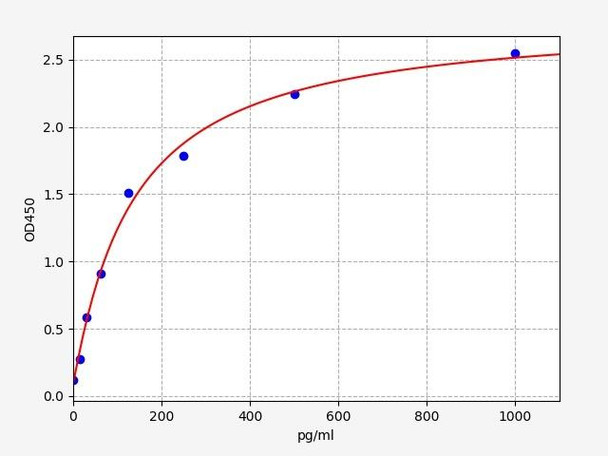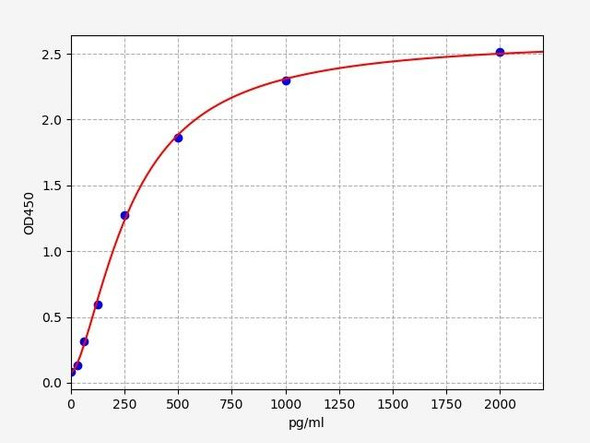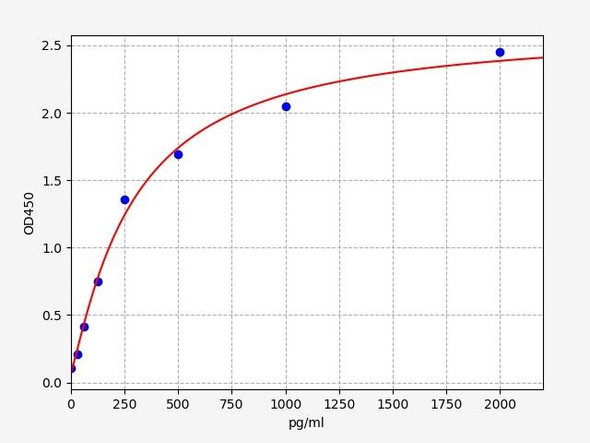Human PDGFB ELISA Kit (HUFI00395)
- SKU:
- HUFI00395
- Product Type:
- ELISA Kit
- Size:
- 96 Assays
- Uniprot:
- P01127
- Sensitivity:
- 9.375pg/ml
- Range:
- 15.625-1000pg/ml
- ELISA Type:
- Sandwich
- Synonyms:
- PDGFB, B chain, Becaplermin, FLJ12858, PDGF subunit B, PDGF2, PDGF-2, platelet-derived growth factor 2, Platelet-derived growth factor beta polypeptide, platelet-derived growth factor subunit B, platelet-derived growth factor, B chain
- Reactivity:
- Human
- Research Area:
- Cell Biology
Description
Human PDGFB ELISA Kit
The Human PDGFB (Platelet-Derived Growth Factor-BB) ELISA Kit is specifically designed for the precise quantification of PDGFB levels in human serum, plasma, and cell culture supernatants. This kit offers exceptional sensitivity and specificity, guaranteeing accurate and consistent results for various research purposes.PDGFB is a key growth factor that plays a crucial role in cell growth, proliferation, and differentiation. It is involved in processes such as wound healing, angiogenesis, and tissue remodeling.
Dysregulation of PDGFB has been linked to various diseases, including cancers, fibrotic disorders, and cardiovascular diseases, highlighting its significance as a potential biomarker for disease progression and therapeutic targeting.With its advanced technology and reliable performance, the Human PDGFB ELISA Kit provides researchers with a valuable tool for studying the role of PDGFB in health and disease, potentially leading to new insights and treatment strategies.
| Product Name: | Human PDGFB ELISA Kit |
| Product Code: | HUFI00395 |
| Size: | 96 Assays |
| Alias: | PDGFB, B chain, Becaplermin, FLJ12858, PDGF subunit B, PDGF2, PDGF-2, platelet-derived growth factor 2, Platelet-derived growth factor beta polypeptide, platelet-derived growth factor subunit B, platelet-derived growth factor, B chain |
| Detection method: | Sandwich ELISA, Double Antibody |
| Application: | This immunoassay kit allows for the in vitro quantitative determination of Human PDGFB concentrations in serum plasma and other biological fluids. |
| Sensitivity: | 9.375pg/ml |
| Range: | 15.625-1000pg/ml |
| Storage: | 4°C for 6 months |
| Note: | For Research Use Only |
| Recovery: | Matrices listed below were spiked with certain level of Human PDGFB and the recovery rates were calculated by comparing the measured value to the expected amount of Human PDGFB in samples. | ||||||||||||||||
| |||||||||||||||||
| Linearity: | The linearity of the kit was assayed by testing samples spiked with appropriate concentration of Human PDGFB and their serial dilutions. The results were demonstrated by the percentage of calculated concentration to the expected. | ||||||||||||||||
| |||||||||||||||||
| CV(%): | Intra-Assay: CV<8% Inter-Assay: CV<10% |
| Component | Quantity | Storage |
| ELISA Microplate (Dismountable) | 8×12 strips | 4°C for 6 months |
| Lyophilized Standard | 2 | 4°C/-20°C |
| Sample/Standard Dilution Buffer | 20ml | 4°C |
| Biotin-labeled Antibody(Concentrated) | 120ul | 4°C (Protect from light) |
| Antibody Dilution Buffer | 10ml | 4°C |
| HRP-Streptavidin Conjugate(SABC) | 120ul | 4°C (Protect from light) |
| SABC Dilution Buffer | 10ml | 4°C |
| TMB Substrate | 10ml | 4°C (Protect from light) |
| Stop Solution | 10ml | 4°C |
| Wash Buffer(25X) | 30ml | 4°C |
| Plate Sealer | 5 | - |
Other materials and equipment required:
- Microplate reader with 450 nm wavelength filter
- Multichannel Pipette, Pipette, microcentrifuge tubes and disposable pipette tips
- Incubator
- Deionized or distilled water
- Absorbent paper
- Buffer resevoir
| Uniprot | P01127 |
| UniProt Protein Function: | PDGFB: Growth factor that plays an essential role in the regulation of embryonic development, cell proliferation, cell migration, survival and chemotaxis. Potent mitogen for cells of mesenchymal origin. Required for normal proliferation and recruitment of pericytes and vascular smooth muscle cells in the central nervous system, skin, lung, heart and placenta. Required for normal blood vessel development, and for normal development of kidney glomeruli. Plays an important role in wound healing. Signaling is modulated by the formation of heterodimers with PDGFA. A chromosomal aberration involving PDGFB is found in dermatofibrosarcoma protuberans. Translocation t(17;22)(q22;q13) with PDGFB. Belongs to the PDGF/VEGF growth factor family. |
| UniProt Protein Details: | Protein type:Oncoprotein; Secreted, signal peptide; Motility/polarity/chemotaxis; Secreted Chromosomal Location of Human Ortholog: 22q13.1 Cellular Component: Golgi membrane; extracellular space; cell surface; basolateral plasma membrane; endoplasmic reticulum lumen; cytoplasm; extracellular region Molecular Function:collagen binding; identical protein binding; protein binding; protein homodimerization activity; growth factor activity; protein heterodimerization activity; platelet-derived growth factor binding; platelet-derived growth factor receptor binding; superoxide-generating NADPH oxidase activator activity; chemoattractant activity Biological Process: extracellular matrix organization and biogenesis; positive regulation of cyclin-dependent protein kinase activity; nerve growth factor receptor signaling pathway; positive regulation of transcription, DNA-dependent; heart development; positive regulation of fibroblast growth factor receptor signaling pathway; cell projection biogenesis; protein amino acid phosphorylation; positive regulation of MAP kinase activity; monocyte chemotaxis; positive regulation of fibroblast proliferation; positive chemotaxis; transforming growth factor beta receptor signaling pathway; cell growth; positive regulation of mitotic cell cycle, embryonic; response to drug; substrate-bound cell migration; platelet activation; fibroblast growth factor receptor signaling pathway; positive regulation of mitosis; positive regulation of chemotaxis; activation of protein kinase B; positive regulation of blood vessel endothelial cell migration; positive regulation of protein amino acid autophosphorylation; positive regulation of phosphoinositide 3-kinase cascade; positive regulation of peptidyl-tyrosine phosphorylation; activation of protein kinase activity; blood vessel morphogenesis; positive regulation of endothelial cell proliferation; negative regulation of transcription, DNA-dependent; actin cytoskeleton organization and biogenesis; embryonic placenta development; peptidyl-tyrosine phosphorylation; positive regulation of smooth muscle cell proliferation; platelet-derived growth factor receptor signaling pathway; positive regulation of smooth muscle cell migration; response to estradiol stimulus; response to insulin stimulus; platelet degranulation; positive regulation of MAPKKK cascade; positive regulation of glomerular filtration; positive regulation of cell proliferation; response to wounding; hemopoiesis; DNA replication; negative regulation of cell migration; epidermal growth factor receptor signaling pathway; phosphoinositide-mediated signaling; negative regulation of phosphatidylinositol biosynthetic process; positive regulation of phosphoinositide 3-kinase activity; peptidyl-serine phosphorylation; response to hypoxia; innate immune response; blood coagulation; positive regulation of DNA replication; positive regulation of cell migration Disease: Meningioma, Familial, Susceptibility To; Dermatofibrosarcoma Protuberans; Basal Ganglia Calcification, Idiopathic, 5; Basal Ganglia Calcification, Idiopathic, 1 |
| NCBI Summary: | The protein encoded by this gene is a member of the platelet-derived growth factor family. The four members of this family are mitogenic factors for cells of mesenchymal origin and are characterized by a motif of eight cysteines. This gene product can exist either as a homodimer (PDGF-BB) or as a heterodimer with the platelet-derived growth factor alpha polypeptide (PDGF-AB), where the dimers are connected by disulfide bonds. Mutations in this gene are associated with meningioma. Reciprocal translocations between chromosomes 22 and 17, at sites where this gene and that for collagen type 1, alpha 1 are located, are associated with a particular type of skin tumor called dermatofibrosarcoma protuberans resulting from unregulated expression of growth factor. Two alternatively spliced transcript variants encoding different isoforms have been identified for this gene. [provided by RefSeq, Feb 2013] |
| UniProt Code: | P01127 |
| NCBI GenInfo Identifier: | 129724 |
| NCBI Gene ID: | 5155 |
| NCBI Accession: | P01127.1 |
| UniProt Secondary Accession: | P01127,P78431, Q15354, Q6FHE7, Q9UF23, G3XAG8, |
| UniProt Related Accession: | P01127 |
| Molecular Weight: | 241 |
| NCBI Full Name: | Platelet-derived growth factor subunit B |
| NCBI Synonym Full Names: | platelet-derived growth factor beta polypeptide |
| NCBI Official Symbol: | PDGFB |
| NCBI Official Synonym Symbols: | SIS; SSV; IBGC5; PDGF2; c-sis; PDGF-2 |
| NCBI Protein Information: | platelet-derived growth factor subunit B; becaplermin; PDGF, B chain; PDGF subunit B; proto-oncogene c-Sis; platelet-derived growth factor 2; platelet-derived growth factor B chain; platelet-derived growth factor, beta polypeptide (oncogene SIS); platelet-derived growth factor beta polypeptide (simian sarcoma viral (v-sis) oncogene homolog) |
| UniProt Protein Name: | Platelet-derived growth factor subunit B |
| UniProt Synonym Protein Names: | PDGF-2; Platelet-derived growth factor B chain; Platelet-derived growth factor beta polypeptide; Proto-oncogene c-Sis; INN: Becaplermin |
| Protein Family: | Platelet-derived growth factor |
| UniProt Gene Name: | PDGFB |
| UniProt Entry Name: | PDGFB_HUMAN |
*Note: Protocols are specific to each batch/lot. For the correct instructions please follow the protocol included in your kit.
Before adding to wells, equilibrate the SABC working solution and TMB substrate for at least 30 min at 37°C. When diluting samples and reagents, they must be mixed completely and evenly. It is recommended to plot a standard curve for each test.
| Step | Protocol |
| 1. | Set standard, test sample and control (zero) wells on the pre-coated plate respectively, and then, record their positions. It is recommended to measure each standard and sample in duplicate. Wash plate 2 times before adding standard, sample and control (zero) wells! |
| 2. | Aliquot 0.1ml standard solutions into the standard wells. |
| 3. | Add 0.1 ml of Sample / Standard dilution buffer into the control (zero) well. |
| 4. | Add 0.1 ml of properly diluted sample ( Human serum, plasma, tissue homogenates and other biological fluids.) into test sample wells. |
| 5. | Seal the plate with a cover and incubate at 37 °C for 90 min. |
| 6. | Remove the cover and discard the plate content, clap the plate on the absorbent filter papers or other absorbent material. Do NOT let the wells completely dry at any time. Wash plate X2. |
| 7. | Add 0.1 ml of Biotin- detection antibody working solution into the above wells (standard, test sample & zero wells). Add the solution at the bottom of each well without touching the side wall. |
| 8. | Seal the plate with a cover and incubate at 37°C for 60 min. |
| 9. | Remove the cover, and wash plate 3 times with Wash buffer. Let wash buffer rest in wells for 1 min between each wash. |
| 10. | Add 0.1 ml of SABC working solution into each well, cover the plate and incubate at 37°C for 30 min. |
| 11. | Remove the cover and wash plate 5 times with Wash buffer, and each time let the wash buffer stay in the wells for 1-2 min. |
| 12. | Add 90 µl of TMB substrate into each well, cover the plate and incubate at 37°C in dark within 10-20 min. (Note: This incubation time is for reference use only, the optimal time should be determined by end user.) And the shades of blue can be seen in the first 3-4 wells (with most concentrated standard solutions), the other wells show no obvious color. |
| 13. | Add 50 µl of Stop solution into each well and mix thoroughly. The color changes into yellow immediately. |
| 14. | Read the O.D. absorbance at 450 nm in a microplate reader immediately after adding the stop solution. |
When carrying out an ELISA assay it is important to prepare your samples in order to achieve the best possible results. Below we have a list of procedures for the preparation of samples for different sample types.
| Sample Type | Protocol |
| Serum | If using serum separator tubes, allow samples to clot for 30 minutes at room temperature. Centrifuge for 10 minutes at 1,000x g. Collect the serum fraction and assay promptly or aliquot and store the samples at -80°C. Avoid multiple freeze-thaw cycles. If serum separator tubes are not being used, allow samples to clot overnight at 2-8°C. Centrifuge for 10 minutes at 1,000x g. Remove serum and assay promptly or aliquot and store the samples at -80°C. Avoid multiple freeze-thaw cycles. |
| Plasma | Collect plasma using EDTA or heparin as an anticoagulant. Centrifuge samples at 4°C for 15 mins at 1000 × g within 30 mins of collection. Collect the plasma fraction and assay promptly or aliquot and store the samples at -80°C. Avoid multiple freeze-thaw cycles. Note: Over haemolysed samples are not suitable for use with this kit. |
| Urine & Cerebrospinal Fluid | Collect the urine (mid-stream) in a sterile container, centrifuge for 20 mins at 2000-3000 rpm. Remove supernatant and assay immediately. If any precipitation is detected, repeat the centrifugation step. A similar protocol can be used for cerebrospinal fluid. |
| Cell culture supernatant | Collect the cell culture media by pipette, followed by centrifugation at 4°C for 20 mins at 1500 rpm. Collect the clear supernatant and assay immediately. |
| Cell lysates | Solubilize cells in lysis buffer and allow to sit on ice for 30 minutes. Centrifuge tubes at 14,000 x g for 5 minutes to remove insoluble material. Aliquot the supernatant into a new tube and discard the remaining whole cell extract. Quantify total protein concentration using a total protein assay. Assay immediately or aliquot and store at ≤ -20 °C. |
| Tissue homogenates | The preparation of tissue homogenates will vary depending upon tissue type. Rinse tissue with 1X PBS to remove excess blood & homogenize in 20ml of 1X PBS (including protease inhibitors) and store overnight at ≤ -20°C. Two freeze-thaw cycles are required to break the cell membranes. To further disrupt the cell membranes you can sonicate the samples. Centrifuge homogenates for 5 mins at 5000xg. Remove the supernatant and assay immediately or aliquot and store at -20°C or -80°C. |
| Tissue lysates | Rinse tissue with PBS, cut into 1-2 mm pieces, and homogenize with a tissue homogenizer in PBS. Add an equal volume of RIPA buffer containing protease inhibitors and lyse tissues at room temperature for 30 minutes with gentle agitation. Centrifuge to remove debris. Quantify total protein concentration using a total protein assay. Assay immediately or aliquot and store at ≤ -20 °C. |
| Breast Milk | Collect milk samples and centrifuge at 10,000 x g for 60 min at 4°C. Aliquot the supernatant and assay. For long term use, store samples at -80°C. Minimize freeze/thaw cycles. |






